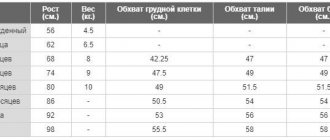Girls height:
WHO table up to 10 years
Growth chart for girls under 17 years old
Child growth stages
Calculating the height of boys and girls
Below is a calculator for calculating a child's height.
Enter the child’s gender, age and height value, click the “Show result” button and see a comparison of your child’s indicator with the standard encyclopedic normal.
But we know that this is just a comparative characteristic and nothing more. There is no longer any need to look at many tables and look for the required indicator among a huge number of numbers, it still doesn’t mean much, it’s better to take a walk with your child.
- Chest circumference calculator
- Weight calculator
- Baby head circumference calculator
- Height to weight ratio calculator
Growth is an increase in the amount of mass and body size. Growth is one of the main manifestations of life, as well as the most sensitive indicator of the general health of a child.
Especially at first, we watch how quickly our baby grows. We notice that that raincoat that was “just in time” becomes small, or a favorite dress has become tight, and our child is growing. Clothes sizes change one after another in quick succession, and the baby becomes big.
A child grows rapidly in the first four years of life. In subsequent years, growth and development become consistent. Nutrients such as vitamins and minerals are required for normal growth and development. A healthy and varied diet is of great importance for a child.
Every mother is interested in the development of her baby. If a mother is short, she is interested in whether her child will be short; usually mothers are more worried about boys, because... For a girl, short stature is not a problem. Although all this is not so important, the main thing is that the baby is healthy. Below is a chart of the growth of boys in the first 10 years of life. Indicators that fall in the range between “below average” and “above average” are considered to be the norm.
Normal height and weight
The answer to the question “How much should a one-year-old baby weigh and how tall should it be?” can be found in the table created according to WHO data:
| 1 year | Bottom line | Upper limit |
| Boys' weight, kg | 7,7 | 12,0 |
| Girls' weight, kg | 7,0 | 11,5 |
| Boys' height, cm | 71,0 | 80,5 |
| Girls' height, cm | 68,9 | 79,2 |
| Boys' head circumference, cm | 43,5 | 48,6 |
| Head circumference of girls, cm | 42,2 | 47,6 |
However, pediatricians claim that in fact, the minimum height and weight of children is higher, and only a few grow to the maximum values. WHO simply “gives room for creativity” to children’s bodies and reduces the possibility of anxiety among parents.
In the first year of life, the child’s normal height increases by 20-27 cm. The baby gains his 15 cm in the first 6 months, and already in the second half of the year he gains the remaining centimeters.
In medicine, a child who has not reached 71 cm in one year is called short, while a baby who has grown to 91 cm is called tall.
If a child is on the threshold of a minimum or maximum in indicators, there is no need to do anything. This is the normal course of its development.
WHO growth chart for boys from 0 to 10 years
| Age | Very low | Short | Below the average | Average | Above average | High | Very tall |
| Newborn | 44.2 | 46.1 | 48.0 | 49.9 | 51.8 | 53.7 | 55.6 |
| 1 month | 48.9 | 50.8 | 52.8 | 54.7 | 56.7 | 58.6 | 60.6 |
| 2 months | 52.4 | 54.4 | 56.4 | 58.4 | 60.4 | 62.4 | 64.4 |
| 3 months | 55.3 | 57.3 | 59.4 | 61.4 | 63.5 | 65.5 | 67.6 |
| 4 months | 57.6 | 59.7 | 61.8 | 63.9 | 66.0 | 68.0 | 70.1 |
| 5 months | 59.6 | 61.7 | 63.8 | 65.9 | 68.0 | 70.1 | 72.2 |
| 6 months | 61.2 | 63.3 | 65.5 | 67.6 | 69.8 | 71.9 | 74.0 |
| 7 months | 62.7 | 64.8 | 67.0 | 69.2 | 71.3 | 73.5 | 75.7 |
| 8 months | 64.0 | 66.2 | 68.4 | 70.6 | 72.8 | 75.0 | 77.2 |
| 9 months | 65.2 | 67.5 | 69.7 | 72.0 | 74.2 | 76.5 | 78.7 |
| 10 months | 66.4 | 68.7 | 71.0 | 73.3 | 75.6 | 77.9 | 80.1 |
| 11 months | 67.6 | 69.9 | 72.2 | 74.5 | 76.9 | 79.2 | 81.5 |
| 1 year | 68.6 | 71.0 | 73.4 | 75.7 | 78.1 | 80.5 | 82.9 |
| 1 year 3 months | 71.6 | 74.1 | 76.6 | 79.1 | 81.7 | 84.2 | 86.7 |
| 1 year 6 months | 74.2 | 76.9 | 79.6 | 82.3 | 85.0 | 87.7 | 90.4 |
| 1 year 9 months | 76.5 | 79.4 | 82.3 | 85.1 | 88.0 | 90.9 | 93.8 |
| 2 years | 78.7 | 81.7 | 84.8 | 87.8 | 90.9 | 93.9 | 97.0 |
| 2 years 3 months | 79.9 | 83.1 | 86.4 | 89.6 | 92.9 | 96.1 | 99.3 |
| 2 years 6 months | 81.7 | 85.1 | 88.5 | 91.9 | 95.3 | 98.7 | 102.1 |
| 2 years 9 months | 83.4 | 86.9 | 90.5 | 94.1 | 97.6 | 101.2 | 104.8 |
| 3 years | 85.0 | 88.7 | 92.4 | 96.1 | 99.8 | 103.5 | 107.2 |
| 3 years 3 months | 86.5 | 90.3 | 94.2 | 98.0 | 101.8 | 105.7 | 109.5 |
| 3 years 6 months | 88.0 | 91.9 | 95.9 | 99.9 | 103.8 | 107.8 | 111.7 |
| 3 years 9 months | 89.4 | 93.5 | 97.5 | 101.6 | 105.7 | 109.8 | 113.9 |
| 4 years | 90.7 | 94.9 | 99.1 | 103.3 | 107.5 | 111.7 | 115.9 |
| 4 years 3 months | 92.1 | 96.4 | 100.7 | 105.0 | 109.3 | 113.6 | 117.9 |
| 4 years 6 months | 93.4 | 97.8 | 102.3 | 106.7 | 111.1 | 115.5 | 119.9 |
| 4 years 9 months | 94.7 | 99.3 | 103.8 | 108.3 | 112.8 | 117.4 | 121.9 |
| 5 years | 96.1 | 100.7 | 105.3 | 110.0 | 114.6 | 119.2 | 123.9 |
| 5 years 6 months | 98.7 | 103.4 | 108.2 | 112.9 | 117.7 | 122.4 | 127.1 |
| 6 years | 101.2 | 106.1 | 111.0 | 116.0 | 120.9 | 125.8 | 130.7 |
| 6 years b months | 103.6 | 108.7 | 113.8 | 118.9 | 124.0 | 129.1 | 134.2 |
| 7 years | 105.9 | 111.2 | 116.4 | 121.7 | 127.0 | 132.3 | 137.6 |
| 8 years | 110.3 | 116.0 | 121.6 | 127.3 | 132.9 | 138.6 | 144.2 |
| 9 years | 114.5 | 120.5 | 126.6 | 132.6 | 138.6 | 144.6 | 150.6 |
| 10 years | 119.4 | 125.8 | 132.2 | 138.6 | 145.0 | 151.4 | 157.8 |

Height indicators are indicated in centimeters.
Weight of boys under 10 years old (WHO)
Head circumference of boys under 5 years (WHO)
I would like to note that the table data shows average values. If your child does not fit into the average, do not worry: there are many factors that affect a child’s growth.
Growth indicators
A child's weight and height are interrelated. If weight gain should occur gradually, then height can change sharply, spasmodically. What growth standards should a healthy baby meet? Here is an approximate table of height and weight indicators depending on the child’s age (six months).
| Boys (weight) | 6500 – 9000 g |
| Boys (height) | 63 – 70 cm |
| Girls (weight) | 6300 – 8300 g |
| Girls (height) | 62 – 69 cm |
In order for the baby to develop well and gain weight and height normally, he needs not only to eat right, but also to move a lot, walk in the fresh air, and devote a sufficient amount of time to sleep. Let's talk in more detail about the sleep patterns and motor skills of a six-month-old baby: how much and how should he sleep and move?
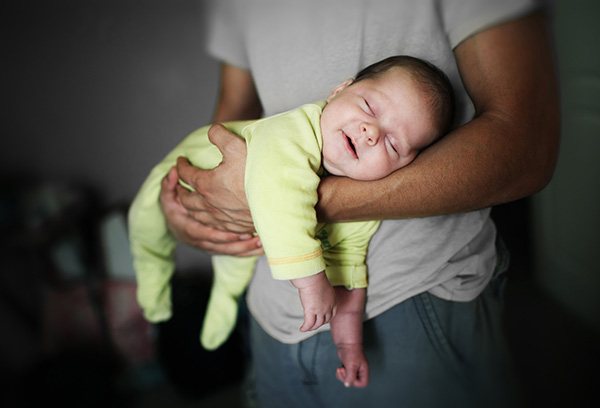
Centile height chart for boys under 17 years of age
| Age | Very low | Short | Below the average | Average | Above average | High | Very tall |
| newborn | 46,5 | 48,0 | 49,8 | 51,3 | 52,3 | 53,5 | 55,0 |
| 1 month | 49,5 | 51,2 | 52,7 | 54,5 | 55,6 | 56,5 | 57,3 |
| 2 months | 52,6 | 53,8 | 55,3 | 57,3 | 58,2 | 59,4 | 60,9 |
| 3 months | 55,3 | 56,5 | 58,1 | 60,0 | 60,9 | 62,0 | 63,8 |
| 4 months | 57,5 | 58,7 | 60,6 | 62,0 | 63,1 | 64,5 | 66,3 |
| 5 months | 59,9 | 61,1 | 62,3 | 64,3 | 65,6 | 67,0 | 68,9 |
| 6 months | 61,7 | 63,0 | 64,8 | 66,1 | 67,7 | 69,0 | 71,2 |
| 7 months | 63,8 | 65,1 | 66,3 | 68,0 | 69,8 | 71,1 | 73,5 |
| 8 months | 65,5 | 66,8 | 68,1 | 70,0 | 71,3 | 73,1 | 75,3 |
| 9 months | 67,3 | 68,2 | 69,8 | 71,3 | 73,2 | 75,1 | 78,8 |
| 10 months | 68,8 | 69,1 | 71,2 | 73,0 | 75,1 | 76,9 | 78,8 |
| 11 months | 70,1 | 71,3 | 72,6 | 74,3 | 76,2 | 78,0 | 80,3 |
| 1 year | 71,2 | 72,3 | 74,0 | 75,5 | 77,3 | 79,7 | 81,7 |
| 1 year 3 months | 74,8 | 75,9 | 77,1 | 79,0 | 81,0 | 83,0 | 85,3 |
| 1.5 years | 76,9 | 78,4 | 79,8 | 81,7 | 83,9 | 85,9 | 89,4 |
| 1 year 9 months | 79,3 | 80,8 | 82,3 | 84,3 | 86,5 | 88,3 | 91,2 |
| 2 years | 81,3 | 83,0 | 84,5 | 86,8 | 89,0 | 90,8 | 94,0 |
| 2 years 3 months | 83,0 | 84,9 | 86,8 | 88,7 | 91,3 | 93,9 | 96,8 |
| 2.5 years | 84,5 | 87,0 | 89,0 | 91,3 | 93,7 | 95,5 | 99,0 |
| 2 years 9 months | 86,3 | 88,8 | 91,3 | 93,5 | 96,0 | 98,1 | 101,2 |
| 3 years | 88,0 | 90,0 | 92,3 | 96,0 | 99,8 | 102,0 | 104,5 |
| 3.5 years | 90,3 | 92,6 | 95,0 | 99,1 | 102,5 | 105,0 | 107,5 |
| 4 years | 93,2 | 95,5 | 98,3 | 102,0 | 105,5 | 108,0 | 110,6 |
| 4.5 years | 96,0 | 98,3 | 101,2 | 105,1 | 108,6 | 111,0 | 113,6 |
| 5 years | 98,9 | 101,5 | 104,4 | 108,3 | 112,0 | 114,5 | 117,0 |
| 5.5 years | 101,8 | 104,7 | 107,8 | 111,5 | 115,1 | 118,0 | 120,6 |
| 6 years | 105,0 | 107,7 | 110,9 | 115,0 | 118,7 | 121,1 | 123,8 |
| 6.5 years | 108,0 | 110,8 | 113,8 | 118,2 | 121,8 | 124,6 | 127,2 |
| 7 years | 111,0 | 113,6 | 116,8 | 121,2 | 125,0 | 128,0 | 130,6 |
| 8 years | 116,3 | 119,0 | 122,1 | 126,9 | 130,8 | 134,5 | 137,0 |
| 9 years | 121,5 | 124,7 | 125,6 | 133,4 | 136,3 | 140,3 | 143,0 |
| 10 years | 126,3 | 129,4 | 133,0 | 137,8 | 142,0 | 146,7 | 149,2 |
| 11 years | 131,3 | 134,5 | 138,5 | 143,2 | 148,3 | 152,9 | 156,2 |
| 12 years | 136,2 | 140,0 | 143,6 | 149,2 | 154,5 | 159,5 | 163,5 |
| 13 years | 141,8 | 145,7 | 149,8 | 154,8 | 160,6 | 166,0 | 170,7 |
| 14 years | 148,3 | 152,3 | 156,2 | 161,2 | 167,7 | 172,0 | 176,7 |
| 15 years | 154,6 | 158,6 | 162,5 | 166,8 | 173,5 | 177,6 | 181,6 |
| 16 years | 158,8 | 163,2 | 166,8 | 173,3 | 177,8 | 182,0 | 186,3 |
| 17 years | 162,8 | 166,6 | 171,6 | 177,3 | 181,6 | 186,0 | 188,5 |
Height indicators are indicated in centimeters.
Weight table for boys under 17 years old
Head circumference table for boys under 16 years old
Indicators that fall in the range between “below average” and “above average” are considered to be the norm. I would like to add that the tables show the average values to which the pediatrician is trying to adjust us. Even if your child does not fit into the normal range, don’t worry, every baby is individual; there are also a number of factors that influence a child’s growth.
Height and weight of a 1 year old child, data from domestic pediatricians
| 1 year | Bottom line | Upper limit |
| Boys' weight, kg | 8,9 | 11,6 |
| Girls' weight, kg | 8,5 | 10,8 |
| Boys' height, cm | 72,3 | 79,7 |
| Girls' height, cm | 71,4 | 78,0 |
| Boys' head circumference, cm | 45,3 | 48,6 |
| Head circumference of girls, cm | 44,2 | 47,3 |
| Boys chest circumference, cm | 46,1 | 52,5 |
| Girls chest circumference, cm | 46,3 | 51,4 |
WHO growth chart for girls aged 0 to 10 years
| Age | Very low | Short | Below the average | Average | Above average | High | Very tall |
| Newborn | 43.6 | 45.4 | 47.3 | 49.1 | 51.0 | 52.9 | 54.7 |
| 1 month | 47.8 | 49.8 | 51.7 | 53.7 | 55.6 | 57.6 | 59.5 |
| 2 months | 51.0 | 53.0 | 55.0 | 57.1 | 59.1 | 61.1 | 63.2 |
| 3 months | 53.5 | 55.6 | 57.7 | 59.8 | 61.9 | 64.0 | 66.1 |
| 4 months | 55.6 | 57.8 | 59.9 | 62.1 | 64.3 | 66.4 | 68.6 |
| 5 months | 57.4 | 59.6 | 61.8 | 64.0 | 66.2 | 68.5 | 70.7 |
| 6 months | 58.9 | 61.2 | 63.5 | 65.7 | 68.0 | 70.3 | 72.5 |
| 7 months | 60.3 | 62.7 | 65.0 | 67.3 | 69.6 | 71.9 | 74.2 |
| 8 months | 61.7 | 64.0 | 66.4 | 68.7 | 71.1 | 73.5 | 75.8 |
| 9 months | 62.9 | 65.3 | 67.7 | 70.1 | 72.6 | 75.0 | 77.4 |
| 10 months | 64.1 | 66.5 | 69.0 | 71.5 | 73.9 | 76.4 | 78.9 |
| 11 months | 65.2 | 67.7 | 70.3 | 72.8 | 75.3 | 77.8 | 80.3 |
| 1 year | 66.3 | 68.9 | 71.4 | 74.0 | 76.6 | 79.2 | 81.7 |
| 1 year 3 months | 69.3 | 72.0 | 74.8 | 77.5 | 80.2 | 83.0 | 85.7 |
| 1.5 years | 72.0 | 74.9 | 77.8 | 80.7 | 83.6 | 86.5 | 89.4 |
| 1 year 9 months | 74.5 | 77.5 | 80.6 | 83.7 | 86.7 | 89.8 | 92.9 |
| 2 years | 76.7 | 80.0 | 83.2 | 86.4 | 89.6 | 92.9 | 96.1 |
| 2 years 3 months | 78.1 | 81.5 | 84.9 | 88.3 | 91.7 | 95.0 | 98.4 |
| 2 years 6 months | 80.1 | 83.6 | 87.1 | 90.7 | 94.2 | 97.7 | 101.3 |
| 2 years 9 months | 81.9 | 85.6 | 89.3 | 92.9 | 96.6 | 100.3 | 103.9 |
| 3 years | 83.6 | 87.4 | 91.2 | 95.1 | 98.9 | 102.7 | 106.0 |
| 3 years 3 months | 85.3 | 89.2 | 93.1 | 97.1 | 101.0 | 105.0 | 108.9 |
| 3 years 6 months | 86.8 | 90.9 | 95.0 | 99.0 | 103.1 | 107.2 | 111.2 |
| 3 years 9 months | 88.4 | 92.5 | 96.7 | 100.9 | 105.1 | 109.3 | 113.5 |
| 4 years | 89.8 | 94.1 | 98.4 | 102.7 | 107.0 | 111.3 | 115.7 |
| 4 years 3 months | 91.2 | 95.6 | 100.1 | 104.5 | 108.9 | 113.3 | 117.7 |
| 4 years 6 months | 92.6 | 97.1 | 101.6 | 106.2 | 110.7 | 115.2 | 119.8 |
| 4 years 9 months | 93.9 | 98.5 | 103.2 | 107.8 | 112.5 | 117.1 | 121.8 |
| 5 years | 95.2 | 99.9 | 104.7 | 109.4 | 114.2 | 118.9 | 123.7 |
| 5 years 6 months | 97.4 | 102.3 | 107.2 | 112.2 | 117.1 | 122.0 | 127.0 |
| 6 years | 99.8 | 104.9 | 110.0 | 115.1 | 120.2 | 125.4 | 130.5 |
| 6 years b months | 102.1 | 107.4 | 112.7 | 118.0 | 123.3 | 128.6 | 133.9 |
| 7 years | 104.4 | 109.9 | 115.3 | 120.8 | 126.3 | 131.7 | 137.2 |
| 8 years | 109.2 | 115.0 | 120.8 | 126.6 | 132.4 | 138.2 | 143.9 |
| 9 years | 114.2 | 120.3 | 126.4 | 132.5 | 138.6 | 144.7 | 150.8 |
| 10 years | 118.7 | 125.0 | 131.4 | 137.8 | 144.2 | 150.5 | 156.9 |

Height indicators are indicated in centimeters.
Head circumference of girls from 0 to 5 years (WHO)
Weight table for girls under 10 years old (WHO)
What determines the weight of a baby?
There is a certain range of reasons that affect a child’s weight. First of all, we are talking about gender: boys and girls of the same age will have different weights. If it so happens that a boy’s weight at birth is lower than that of a girl, then he will subsequently gain more actively gram by gram and soon his weight parameters will be within the norms provided for boys.
It’s an interesting trend for “small” kids to gain weight, because over time they gain weight much faster than “large” kids.
Equally important is the growth of the child at 6 months. Weight indicators cannot be considered separately from height, since without them the doctor will not make objective conclusions about the development of your baby. The taller the baby, the more weight it should have. At the same time, do not forget about the body constitution of parents and other blood relatives.
Centile height chart for girls under 17 years of age
| Age | Very low | Short | Below the average | Average | Above average | High | Very tall |
| newborn | 45,8 | 47,5 | 49,8 | 50,7 | 52,0 | 53,1 | 53,9 |
| 1 month | 48,5 | 50,3 | 52,1 | 53,5 | 55,0 | 56,1 | 57,3 |
| 2 months | 51,2 | 53,3 | 55,2 | 56,8 | 58,0 | 59,3 | 60,6 |
| 3 months | 54,0 | 56,2 | 57,6 | 59,3 | 60,7 | 61,8 | 63,6 |
| 4 months | 56,7 | 58,4 | 60,0 | 61,2 | 62,8 | 64,0 | 65,7 |
| 5 months | 59,1 | 60,8 | 62,0 | 63,8 | 65,1 | 66,0 | 68,0 |
| 6 months | 60,8 | 62,5 | 64,1 | 65,5 | 67,1 | 68,8 | 70,0 |
| 7 months | 62,7 | 64,1 | 65,9 | 67,5 | 69,2 | 70,4 | 71,9 |
| 8 months | 64,5 | 66,0 | 67,5 | 69,0 | 70,5 | 72,5 | 73,7 |
| 9 months | 66,0 | 67,5 | 69,1 | 70,2 | 72,0 | 74,1 | 75,5 |
| 10 months | 67,5 | 69,0 | 70,3 | 71,9 | 73,2 | 75,3 | 76,8 |
| 11 months | 68,9 | 70,1 | 71,5 | 73,0 | 74,7 | 76,5 | 78,1 |
| 1 year | 70,1 | 71,4 | 72,8 | 74,1 | 75,8 | 78,0 | 79,6 |
| 1 year 3 months | 72,9 | 74,5 | 76,0 | 77,1 | 79,1 | 81,5 | 83,4 |
| 1.5 years | 75,8 | 77,1 | 78,9 | 79,9 | 82,1 | 84,5 | 86,8 |
| 1 year 9 months | 78,0 | 79,5 | 81,2 | 82,9 | 84,5 | 87,5 | 89,5 |
| 2 years | 80,1 | 81,7 | 83,3 | 85,2 | 87,5 | 90,1 | 92,5 |
| 2 years 3 months | 82,0 | 83,5 | 85,4 | 87,4 | 90,1 | 92,4 | 95,0 |
| 2.5 years | 83,8 | 85,7 | 87,7 | 89,8 | 92,3 | 95,0 | 97,3 |
| 2 years 9 months | 85,8 | 87,6 | 89,8 | 91,7 | 94,8 | 97,0 | 99,7 |
| 3 years | 89,0 | 90,8 | 93,0 | 95,5 | 98,1 | 100,7 | 103,1 |
| 3.5 years | 91,3 | 93,5 | 95,6 | 98,5 | 101,4 | 103,5 | 106,0 |
| 4 years | 94,0 | 96,1 | 98,5 | 101,5 | 104,1 | 106,9 | 109,7 |
| 4.5 years | 96,8 | 99,3 | 101,5 | 104,4 | 107,4 | 110,5 | 113,2 |
| 5 years | 99,9 | 102,5 | 104,7 | 107,5 | 110,7 | 113,6 | 116,7 |
| 5.5 years | 102,5 | 105,2 | 108,0 | 110,8 | 114,3 | 117,0 | 120,0 |
| 6 years | 105,3 | 108,0 | 110,9 | 114,1 | 118,0 | 120,6 | 124,0 |
| 6.5 years | 108,1 | 110,5 | 114,0 | 117,6 | 121,3 | 124,2 | 127,5 |
| 7 years | 111,1 | 113,6 | 116,9 | 120,8 | 124,8 | 128,0 | 131,3 |
| 8 years | 116,5 | 119,3 | 123,0 | 127,2 | 131,0 | 134,3 | 137,7 |
| 9 years | 122,0 | 124,6 | 128,4 | 132,8 | 137,0 | 140,5 | 144,8 |
| 10 years | 127,0 | 130,5 | 134,3 | 139,0 | 142,9 | 146,7 | 151,0 |
| 11 years | 131,8 | 136,2 | 140,2 | 145,3 | 148,8 | 153,2 | 157,7 |
| 12 years | 137,6 | 142,2 | 145,9 | 150,4 | 154,2 | 159,2 | 163,2 |
| 13 years | 143,0 | 148,3 | 151,8 | 155,5 | 159,8 | 163,7 | 168,0 |
| 14 years | 147,8 | 152,6 | 155,4 | 159,0 | 163,6 | 167,7 | 171,2 |
| 15 years | 150,7 | 154,4 | 157,2 | 161,2 | 166,0 | 169,2 | 173,4 |
| 16 years | 151,6 | 155,2 | 158,0 | 162,5 | 166,8 | 170,2 | 173,8 |
| 17 years | 152,2 | 155,8 | 158,6 | 162,8 | 169,2 | 170,4 | 174,2 |
Height indicators are indicated in centimeters.
Head circumference table for girls under 16 years old
Weight table for girls under 17 years old
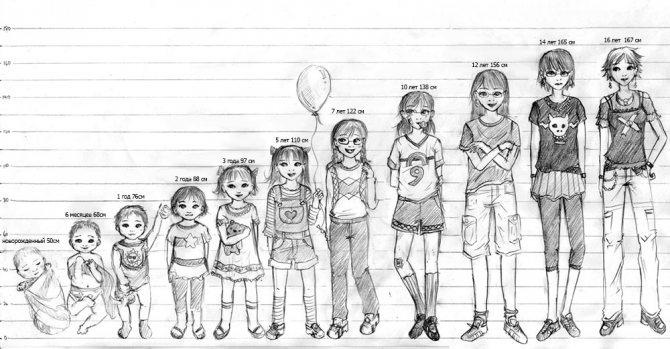
We compare the parameters of the baby’s weight and height
The concept of “body mass index” - BMI - is well known to many parents. This is especially true for those mothers who try to watch their figure. To correctly assess the harmonious development of the baby and identify any deviations in height or weight, you will also need to calculate BMI.

It should be remembered that the normal values for a small child differ from similar values intended for the adult population. The normal BMI for an adult is no more than 25; for children, the same index varies from 13 to 21. Typically, BMI is calculated in order to be able to diagnose the following conditions:
- exhaustion that needs treatment;
- underweight;
- normal weight;
- slightly increased weight (it is within the acceptable range of normal fluctuations);
- overweight;
- obesity that requires treatment.
This index is calculated using a weight and height calculator, which can be found on the Internet. In the fields provided for this, fill in the data - the child’s gender, number of years, current height and weight. Then the “Calculate” button is pressed and the result is evaluated.
Stages of growth in children
The growth process of a child is divided into different stages. The child begins to grow in the womb. During these nine months, the baby grows to almost a third of its future height. After birth, the growth process is divided into the following stages:
Infancy (up to one year)
In the first year of life, the baby grows very quickly. On average, about 25 cm per year.
Preschool age
Between the ages of 2 and 6, the child continues to grow at a steady rate.
School age
At the age of 7-11 years, growth rates slow down, the child grows by an average of 5-6 cm per year
Adolescence
During puberty, the final growth spurt occurs, during which children can grow up to 12 cm per year.
Children's nutritional needs correspond to these changes in growth rates. An infant needs many more calories relative to his size than a preschooler or school-age child. Nutrient needs increase again as a child approaches adolescence.
Features of growth
The growth rate in babies is formed unevenly: in the first 6 months of its life, the baby grows by 15 cm, then the rate gradually decreases. If a child reaches 71 cm per year, then he is usually called short, but if he reaches 81 cm, he will be considered tall. All values between 71 and 81 cm are considered normal and should not cause concern.
It is important to take into account that with tall parents, babies often quickly stretch out, and if dad and mom are short, then the baby will also be quite small. The hereditary factor largely determines the speed of development.
How does a child grow?
The increase in height in the first year of life occurs gradually:
- from 1 to 3 months – by 3 cm monthly;
- from 4 to 6 months – by 2.5 cm;
- from 7 to 9 months - by 1.5 cm;
- from 10 to 12 months - by 1 cm.
Starting from the second year, the growth rate decreases noticeably:
- in the second year the child stretches 10-13 cm;
- for the third - by 6-7 cm;
- for the fourth, fifth - by 5-6 cm.
By the age of five, the child reaches height, the value of which can be calculated using the formula: height at birth multiplied by 2. As a rule, it is close to 1 meter.
Measurement using a special device - a stadiometer - should be carried out regularly, and parents also need to keep a special diary in which the data obtained will be recorded. This will help to track the dynamics of development of each indicator and take timely measures when deviations are identified.

Causes of growth disorders
Sometimes the mother’s behavior during pregnancy causes the baby to be somewhat behind in development. So, if during pregnancy a woman allowed herself to drink alcohol, this can cause a significant lag not only in growth, but also in development. On the contrary, taking vitamins in consultation with a medical specialist can stimulate normal growth rates.
A one-year-old child who is stunted should be given the following foods:
- fish, meat;
- dairy products;
- cereal porridge;
- vegetables and fruits;
- eggs;
- greenery.
The diet should be balanced and healthy - it is important to offer the baby a variety of dishes, introducing each new product with the utmost care.
In addition, if a child is significantly stunted or, on the contrary, much taller than his peers, this may be caused by serious diseases of the thyroid, pancreas, or adrenal glands. Therefore, the problem should not be ignored. One of the reasons for slow growth may also be a lack of somatotropin (growth hormone) in the baby’s body.
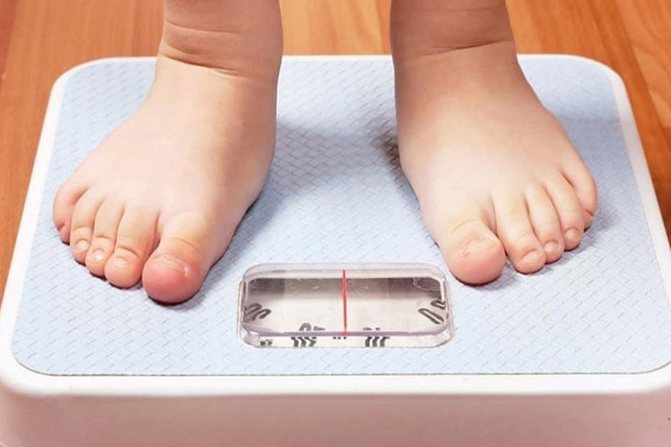
Calculating the height of boys and girls
You are probably wondering how tall your child will be? Many external factors, and even some psychological predispositions, are already known at the time of conception, as a result of the combination of the mother's and father's genes. You can calculate your child’s height using the following formulas:
ETC. — estimated height with an error of +/- 6cm
ETC. (boy) = (Mother's height + father's height + 13): 2
ETC. (girl) = (mother's height + father's height - 13): 2
How to measure a child correctly?
What to focus on?
Approximate numerical values of basic physical indicators can be found in special age tables compiled according to WHO standards.
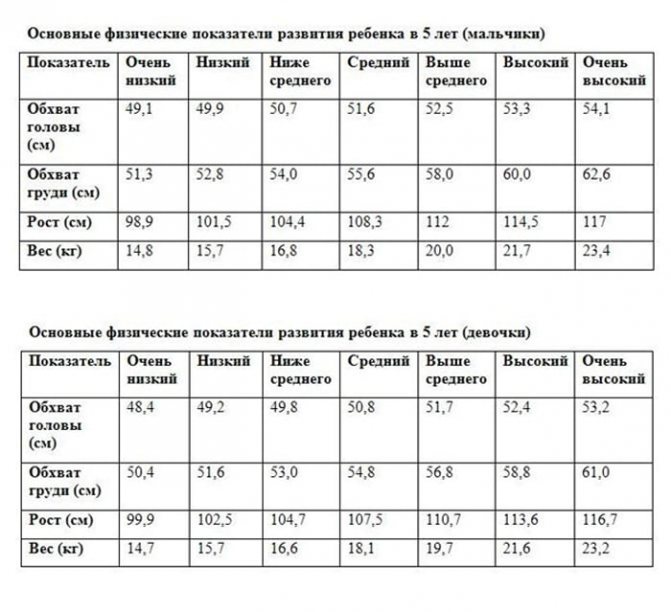
By comparing the parameters of your baby with these data, as well as taking into account all individual factors, they draw a conclusion about his correct physical development. And if necessary, examinations are carried out to assess his state of health. After all, height and weight are one of the main guidelines by which it can be determined. If necessary, doctors prescribe the necessary correction. Because a child’s health is the key to an active, long, fulfilling life.
About large deviations
If the table of height and weight of children under 5 years of age introduces parents to only numbers, and deviations in the weight of a four-year-old child from WHO norms are quite large, then mothers and fathers must rush to consult a doctor. If the weight is low or, on the contrary, too high, this may indicate that there are many unpleasant diseases that, over time, can lead to the development of further ones.
Due to the very large body weight, the cardiovascular system is greatly depressed. Quite often, high blood pressure can be detected in children who are overweight. The extra load also affects the spine.

If children are underweight (underweight), they can get tired quickly. And this does not have a positive effect on their nervous system.
After examining the child, the doctor will give the necessary recommendations regarding the diet in this case. If the doctor suspects the presence of some pathology, he can refer the baby for a more thorough examination by a specialist.
Causes of underweight or excess weight in boys and girls 4 years old
There can be many reasons why a four-year-old child’s weight does not meet the standards established by WHO. However, there are only three main ones:
- improper diet - the child is overfed or his diet lacks substances necessary for growth and development;
- genetic predisposition - the presence of underweight or excess weight in parents (especially if they were observed in childhood);
- developing disease.
In addition, body weight directly depends on the appetite of a small person. Some children eat well, while others struggle to squeeze in even a spoonful of porridge. But the reason for the improvement or deterioration of appetite at this age may be the emotional state of the baby.
Children often react very strongly to changes in their lives. At the age of four, many parents begin to accustom their children to sports or other physical activities, and in kindergarten they are gradually prepared for school. That is, children have additional physical activity that they are not yet accustomed to.
In addition, it is during this age period that children begin to actively communicate with each other. As a result, the child develops friendships with some people, and conflicts arise with others. All this creates additional stress on the nervous system, which leads to changes in appetite. And both in one and the other direction.
What to do if a 4-year-old child’s weight is not normal?
What to do if the child is too fat or too thin? Usually, with small deviations from the norm, it is enough to slightly change the baby’s diet and eating habits.
Of course, there is no need to introduce fundamental changes. But organizing 4 or 5 meals a day for your baby is quite acceptable. At the same time, you should not offer both thin and plump children huge portions. A homemade breakfast may well consist of fruit and a glass of juice. The baby will eat porridge later - in kindergarten. This will be the second breakfast. Lunch and afternoon tea can be ordinary, but dinner can be made lighter. Vegetable salad or cottage cheese is quite enough. No one should overeat at night.
In addition, it is worth observing the behavior of a boy or girl. Some children at four years old cannot yet clearly determine the degree of their hunger. Because of this, they remain hungry for a long time, and then suddenly begin to be capricious and ask for food. However, they eat little because they are already tired and nervous. In this case, to normalize weight, it is enough to simply follow the feeding regime.
And of course you need to monitor the quality of food. It is worth remembering that food should contain a large amount of proteins and microelements necessary for a growing body. But it is advisable to reduce the amount of fats and carbohydrates. There is no need to get carried away with sandwiches. Such an unscheduled snack can lead to the fact that a daughter or son refuses normal food during a planned meal. And, of course, you need to completely give up fast food: hamburgers, French fries, cola and other unhealthy foods that are loved by many children.
If the deviations in the weight of a four-year-old child from WHO norms are quite significant, then parents should definitely seek advice from their local physician at their clinic. Severe underweight or excess weight can be a consequence of many unpleasant diseases, and subsequently contribute to the development of new ones.
Too much body weight significantly depresses the cardiovascular system. Overweight children often have high blood pressure. To a large extent, the excess load also affects the spine. And children with low weight often get tired quickly, which is far from good for the nervous system.
In any case, after the examination, the doctor will be able to give the necessary recommendations on the diet, and if pathologies are suspected, he will give a referral for a more thorough examination by a specialist.




